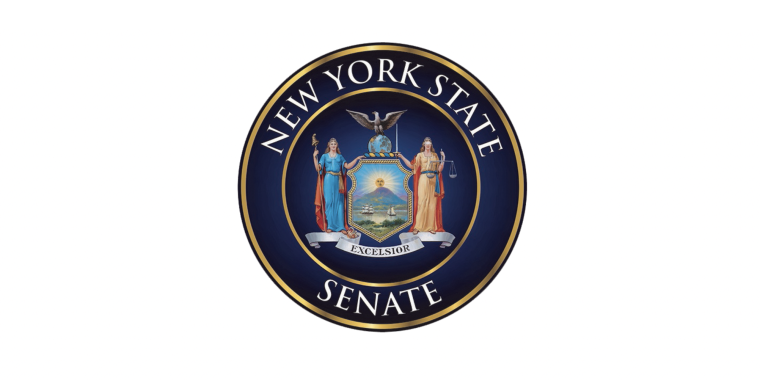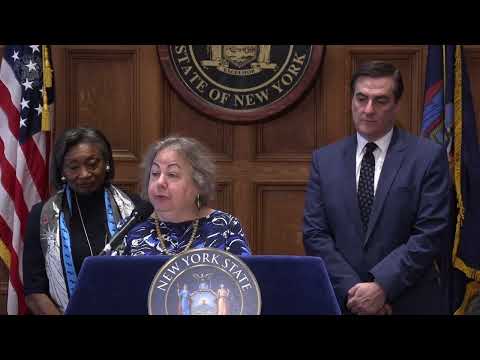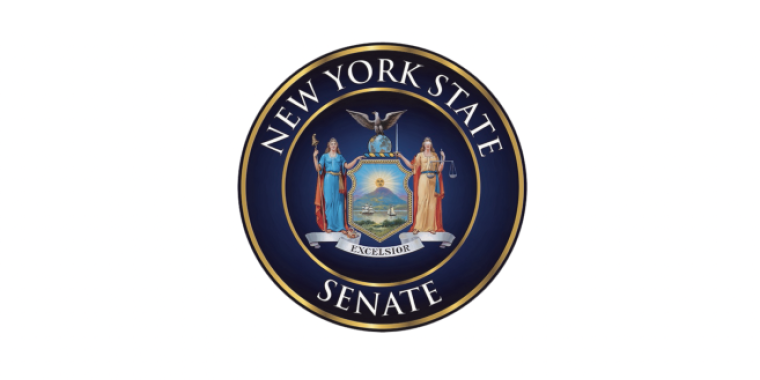
Testimony of Before the New York State Department of Environmental Conservation Regarding the Proposed East 91st Street Marine Transfer Station on October 9, 2007
Liz Krueger
July 15, 2010
My name is Liz Krueger, and I represent the 26th State Senate district, which includes Manhattan's Midtown and East Side. I would like to thank the New York State Department of Environmental Conservation (DEC) for hosting this public hearing on the proposed 91st Street marine transfer station (MTS).
I am here this evening to address a number of serious concerns I have about New York City's Solid Waste Management Plan (SWMP), and express my strong opposition to the proposed construction and operation of a MTS at 91st Street as part of this plan.
I would like to make clear that although the majority of my testimony focuses on the proposed 91st Street MTS in my district, I have long been a strong supporter of the environmental justice movements in New York City and believe that we all must be responsible for our own garbage. I am well aware that for too long, as a result of environmental racism and poor planning, Manhattan's garbage has unfairly burdened low-income and minority communities in the outer boroughs. The inexcusable concentration of waste disposal facilities in a few neighborhoods has contributed to childhood asthma rates in these communities that are among the highest in the nation and has severely undermined economic development. However, because the SWMP does not require private commercial waste haulers in Manhattan to use the more expensive city-owned facilities to be opened in the borough, it is very likely that haulers will continue to use the much less expensive private ones located in the Bronx, Brooklyn and Queens. As a result, it is unlikely that the SWMP will actually lead to a noticeable reduction in the amount of commercial waste brought from Manhattan to the other boroughs.
As a staunch environmentalist, I support the efforts of the Mayor and the Council to incorporate MTS's as part of the City's waste disposal solutions in order to decrease the number of sanitation trucks plaguing our streets. However, I fundamentally oppose operating a MTS in any of New York City's residential neighborhoods. The placement of a MTS at the proposed 91st Street site, a densely populated community immediately adjacent to children's playgrounds and fields, is both irresponsible and myopic. The New York City Department of Sanitation's (DSNY) own siting regulations (Title 16 of the Rules of the City of New York, Chapter 4, Subchapter C) would absolutely prohibit the placement of a private transfer station at this location due to its proximity to residences and parks. The unacceptability of this site for a privately operated MTS should also render it unacceptable for a DSNY operated one.
Impact on the Community
I am extremely concerned about a litany of problems that will arise in my district if the MTS at 91st Street is designed and operated as proposed. A MTS located at 91st Street will have very serious deleterious effects on area parks, traffic, odor, noise, air quality and public health. The residential neighborhood that surrounds the proposed site includes numerous public parks, a major recreational facility, as well as one of Manhattan's largest public housing complexes. The site is just 100 feet from the closest residence, and less than 280 feet from the Stanley Isaacs/Holmes Houses New York City Housing Authority complex which is home to more than 2,200 residents. More than 1,400 children live within 5 blocks of the site. According to census data from 2000, 13,500 people live within a quarter mile radius of the proposed site, including 1,850 children, 1,622 senior citizens, and more than 1,500 people living below the poverty line. For comparison purposes—the next most populated community in which the City proposes to locate a MTS, Hamilton Avenue in Brooklyn, has less than 1/3 the number of people (4,300 people) living within a quarter of a mile radius of that site. Additionally, and disturbingly, 91st Street is the only proposed MTS site not separated from nearby residences by a commercial buffer zone.
The proposed 91st Street site is surrounded by three city parks—Asphalt Green to the west, Carl Schurz Park to the south, and Bobby Wagner Walk to the north. Before the former 91st Street MTS was closed in 1999 (which was less than half the size of the one currently proposed), the trucks would line-up all the way to 86th Street and beyond, and the surrounding neighborhood suffered greatly from odors, vermin and other pollutants. There is no question that the noise, noxious fumes and pollutants from the MTS, as well as the exhaust from the hundreds of trucks that will line up to enter the MTS each day, will dramatically affect the health and safety of the surrounding residents and community facilities.
The SWMP actually calls for the truck access ramp to the MTS to directly bisect the Asphalt Green park and recreational center. Located between York Avenue and the River between 90th and 92nd Streets, Asphalt Green is visited approximately 675,000 times each year. More than 110,000 of these visits are made by public school children at no charge, most from East Harlem. Each year more than 11,000 community members enjoy Asphalt Green's free sports, fitness, theater and educational programs. Even once construction is complete, the noise, fumes and pollutants from the MTS, as well as queuing trucks will likely force Asphalt Green to cancel many of these thriving programs. With dozens of schools sending thousands of children to Asphalt Green for recreational activities, permitting diesel-fuel trucks and other heavy polluters to constantly idle nearby imperils a population particularly susceptible to respiratory ailments. This is not only unsafe but negligent.
Serious legal questions remain about whether the 91st Street MTS could even be constructed without first assessing the impacts of the project on the surrounding parks both during and after construction, and whether the State Legislature must first approve the alienation of parkland at Asphalt Green. The Environmental Impact Statement (EIS) prepared for the project did not consider the impact a 30-month construction period would have on the adjacent parks. In order to demolish and reconstruct the MTS access ramp, the City would have to occupy parkland at Asphalt Green. Even if there was some way to do this work without invading parkland at Asphalt Green and Bobby Wagner Walk, a substantial amount of space would have to be cordoned off in order to protect the safety of those using areas adjacent to a highly active construction site. It is simply inconceivable that the proposed demolition and construction could take place without the closure of some parkland. New York State's courts, including the Court of Appeals, have repeatedly found that the public trust doctrine prohibits a city from converting public parkland to a non-park use without the specific and direct approval of the State Legislature. The courts have found this to be the case even when the disruptions are not permanent.
Inadequate Environmental Review
Since 2004 I have testified at multiple hearings before DSNY and the City Council about the numerous unmitigatable environmental, public health and quality of life problems a MTS at 91st Street would create for the community. Unfortunately, DSNY, as well as the EIS drafted to evaluate impacts of the SWMP, utterly failed to seriously consider these concerns and have not adequately evaluated questions repeatedly raised by community leaders and residents.
The EIS neglected to comprehensively examine both the full impacts of the MTS and effectiveness of the proposed mitigation measures. Among the EIS's countless failings, it does not provide even a basic description of how each MTS will be designed and operated; it does not adequately explain its site-selection criteria; it does not disclose other potential sites that were examined (because there were none) or properly examine four alternative plans; it does not account for a reasonable worst-case scenario given its own figures; it does not maintain internal validity with regard to site-specific impacts like odor and noise; it does not contain any sort of cost-benefit analysis weighing multiple options for long-term disposal solutions; it does not accurately forecast the problems and requisite mitigation measures with regard to noise, odor, air quality, and traffic. As a result the EIS findings are baseless and arguably illegal.
The EIS failed to study the maximum operational capacity of the "converted" MTS at 91st Street, forecasting that it will receive only 1,700 tons per day (tpd) of waste despite possessing the capacity to accommodate 5,280 tpd. The draft DEC permits are written such that DSNY could utilize the full capacity of the MTS only under emergency conditions, but the definition of an emergency condition for solid waste could allow maximum capacity utilization of this site on a regular basis.
The EIS ignored the fact that the proposed MTS is located in an area that has been designated a "Hurricane Zone A." Locations with this designation face "the highest risk of flooding from a hurricane's storm surge" according to the New York City Department of Emergency Management. An evaluation of the potentially dangerous environmental and health effects of flooding at the MTS should have been included in the EIS.
Furthermore, the EIS improperly assumes an average three-and-one-half minute time period for each truck to unload. However, in order to go through the site, unload contents into non-spill containers, turn around, and then exit, each truck would require more than the three-and-one-half-minutes average that the current plan would allow. If trucks took longer to unload their cargo, those that arrived later would begin to queue along the delivery routes. Traffic on the truck routes is already heavily congested—particularly 86th and 90th Streets, and First, Second, and York Avenues. York Avenue, the primary thoroughfare which would be used by sanitation trucks, barely accommodates two bus routes, FDR Drive access, and a high volume of cars already. This will inevitably create a violation of Special Condition # 36 of the DEC's draft permit for the proposed facility, which states that "there shall be no truck queuing on a public street in association with the operation of the subject facility." It is unimaginable that this condition could be met given the fact that the surrounding streets are already highly congested during peak delivery hours.
While idling, waiting to unload the waste that they carried, the trucks would be sitting with their motors running, releasing carbon-, nitrogen-, and sulfur-based pollutants, emitting pungent odors, and creating significant noise pollution. There is no adequate mitigation possible for the situation envisioned. Reconfiguring a few intersections or altering some traffic light patterns would be futile as remedies for this potential disaster.
Flawed EIS Appears to Violate State Laws and Regulations
The EIS appears to violate multiple sections of the State Environmental Quality Review Act ("SEQRA"), notably 6 NYCRR §§ 617.9(b)(1), 617.9(b)(2), and 617.9(b)(5)(iii), which require all Environmental Impact Statements to fully analyze all significant adverse impacts of any action and evaluate all reasonable alternatives. As a result of this litany of errors and procedural contraventions, ACORN, the Gracie Point Community Council, and more than a dozen other neighborhood groups filed an Article 78 lawsuit on October 20, 2005 against Mayor Bloomberg, the City of New York, DSNY, and the City Planning Commission.
Alternative MTS Sites
There must be a better MTS site in Manhattan than East 91st Street—one that will not endanger the health of thousands of residents and prevent the implementation of the SWMP. Unfortunately, the City refused to seriously evaluate or consider any alternate locations in commercial areas of the borough as suggested by elected officials and community groups. These alternate sites include Pier 76 at West 36th Street, which is far from any residential development and is surrounded by rail yards, as well as a number of locations between 29th and 30th Streets and 11th and 12th Avenues that could provide easy access to the Amtrak tunnels which have ample excess capacity during off-hours.
Other Strategies to Address Our City's Waste
If the City is serious about the need to reduce waste and find better ways to accommodate the more than 12,000 tons we produce on a daily basis, there are a number of alternatives that should be included in the SWMP.
First: cut down on the waste we produce. The City should fully support state-level efforts such as proposals I am supporting like: a) banning Styrofoam, b) expanding our "bottle redemption law," through increasing bottle deposits and covering more types of beverage containers, c) recycling of more types of plastic containers, d) urban composting and other models of significantly decreasing our solid waste stream. These proposals could both increase dedicated revenue streams to preserve and promote City recycling and decrease the amount of waste to be transported through MTS sites. Many products, including Styrofoam, hard-cover books, all plastic items other than bottles and jugs, and all glass items other than bottles and jars are just some of the items New Yorkers cannot now recycle. Currently, many businesses are not required to recycle and many large buildings do not offer recycling opportunities. In fact, the New York City Housing Authority (NYCHA), the largest public housing program in the country with nearly half-a-million residents (more than many major U.S. cities) does not offer any recycling programs. Implementing a system to redistribute items like computers, bicycles, and furniture could potentially result in a 15-percent reduction of the waste stream.
Siting new MTS sites anywhere in the City is a short-term solution to a long-term problem that will only get worse as New York is expected to see an increase in over one million residents and tourists in the coming years. New York City must make a real and lasting commitment to expanding recycling, waste reduction and finding high tech solutions to our garbage problems. Focusing on moving waste out of the City on barges and trucks to other localities places us in an extremely vulnerable position. Should the small and uncompetitive market of waste acceptance turn on us, New York will be left with an increased number of MTS sites but nowhere for that waste to go.
There are clearly a number of alternatives yet to be fully explored. While the specifics of the strategy may be cause for disagreement, the SWMP in its current form is inadequate, disingenuous, and likely illegal. At a time when the City seeks to alleviate congestion and be more environmentally friendly, this proposal would achieve the exact opposite effect.
I strongly urge DSNY, the Council and the Mayor to develop a SWMP that truly reduces the unfair burdens currently placed on poor communities and comprehensively plans for the waste management needs of our City while protecting our environment. I strongly urge the DEC to reject the plans for the MTS at East 91st street for all the reasons cited above.
Thank you very much for your attention to these concerns.
Share this Article or Press Release
Newsroom
Go to NewsroomThe Impact of Casinos on Urban Communities
February 23, 2024

An Open Letter From Jewish Elected Officials Regarding The War In Gaza
February 20, 2024


